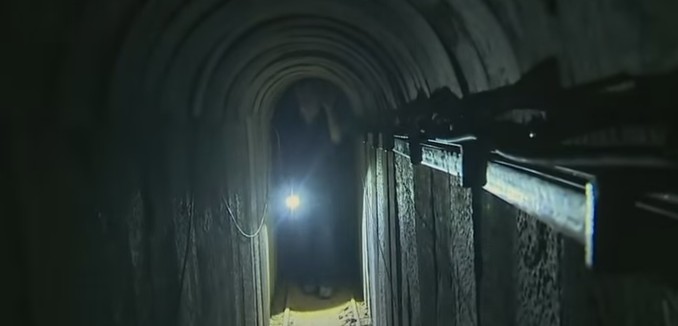Israel has started constructing an underground barrier along its border with the Gaza Strip to block the Islamist terrorist group Hamas from tunneling into its territory, The Times of Israel reported on Wednesday.
Israel’s Defense Ministry in July approved a budget of NIS 2 billion or $530 million to build the concrete barrier along its 37-mile border with Gaza, which has been ruled by Hamas since 2007.
Work on the barrier has begun in the area of the Sha’ar Hanegev Regional Council, which parallels northern Gaza. It will consist of both a physical wall and high-tech detection systems to prevent infiltrations. Israeli officials told the Associated Press that the construction of the barrier, which will extend hundreds of feet underground, could take years to complete.
Israel Defense Forces Chief of Staff Gadi Eisenkot described the barrier as “the largest project” ever undertaken in Israel’s military history. The IDF called for its construction shortly after the conclusion of the 2014 war between Israel and Hamas, known as Operation Protective Edge. The Palestinian terrorist group used its tunnel system to carry out a number of attacks against Israel during the 50-day conflict, and the IDF retaliated by destroying over 30 Hamas tunnels, 14 of which extended into Israel.
Hamas, which has embarked on a project of building new cross-border tunnels in seeming preparation for a future war, has threatened to strike Israel if the new wall is built. According to a report earlier this month, Hamas spends an estimated $40 million of its $100 million military budget on building tunnels into Israel that can be used in future terrorist attacks. In July, an Israeli official estimated that Hamas digs some six miles of tunnels every month.
Dore Gold, the director general of Israel’s Foreign Ministry, said in May that Hamas is stealing some 95 percent of the cement that enters Gaza, which is intended for civilian reconstruction projects. “From our own investigations we found that out of every 100 sacks of cement that come into the Gaza Strip [from Israel], only five or six are transferred to civilians,” he stated. Hamas uses the cement to build and expand its underground infrastructure.
In the spring, the IDF uncovered two Hamas tunnels that breached Israeli territory, the first such discovery since the conclusion of the 2014 Gaza conflict. Gen. Yossi Kuperwasser, formerly the head of the research division of Israeli military intelligence and later the director general of the Ministry of Strategic Affairs, told reporters in May that the tunnels were a sign that Hamas is preparing for another war against Israel. “They definitely invest a lot in making the necessary preparations so that in the next round, when they decide to start it, they will be able to inflict the heaviest damage on Israel, including through those tunnels,” he said.
While Hamas smuggles most of its materials through its crossings with Israel, it also uses smuggling tunnels from the Sinai Peninsula, where Egyptian authorities uncovered a 2.5-kilometer (1.5 mile) tunnel earlier in September. Hamas is working with top officials from ISIS’s Sinai affiliate to facilitate its smuggling operations along the Egyptian border. The ISIS official in charge of coordinating the effort, Abd al-Rahman Barhame, currently lives in Gaza under the protection of Hamas’ armed wing, the Izz ad-Din al-Qassam Brigades. In December, an ISIS commander met with Hamas officials to increase cooperation between the terrorist groups, especially in the area of arms smuggling.
In Your Complete Guide to Hamas’ Network of Terror Tunnels, which was published in the April 2016 issue of The Tower Magazine, Dan Feferman observed that Gaza’s civilians pay the price for Hamas’ efforts to rebuild its tunnels.
There is a tragic side to Hamas’ tunnel strategy. Roughly 9,000 homes were destroyed during Protective Edge, and very few have been rebuilt. This is not Israel’s fault, as building supplies flow regularly into Gaza. But according to declassified intelligence reports, these supplies are routinely stolen by Hamas in order to serve the group’s terrorist purposes. Hamas smuggles in cement, diverts from construction and humanitarian donations, and even raids civilian construction sites in order to rebuild its tunnels. Estimates are that one tunnel can cost a million dollars to build and uses around 50,000 tons of concrete. Close to a million tons of concrete were poured into the terror tunnels before 2014.
The tunnels, in this sense, are a zero-sum game. If the same materials were put into reconstruction, the Gazan people would be better off and, lacking this crucial asymmetric warfare capability, Hamas would be less tempted to attack Israel. On the other hand, with the same limited materials going to terror tunnels, the people of Gaza continue to live in ruins while Hamas rebuilds its war machine.
While Hamas appears to be deterred in the short term, it continues to believe that the tunnels are its only strategic weapon. While it may not be interested in another war, the tunnels continue to be dug for a reason. Once used, however, they lose their effectiveness, as the IDF knows their locations and can thus destroy them. Hamas is well aware of this dilemma. The tunnels essentially leave Israel and Hamas in an arms race—with Israel racing to develop a technological solution before Hamas decides to launch another round of fighting.
[Photo: CNN / YouTube ]




